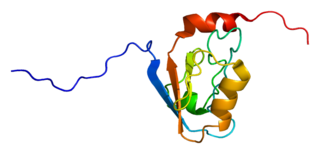Plexin-B2 is a protein that in humans is encoded by the PLXNB2 gene. [5] [6] [7]
Plexin-B2 is a protein that in humans is encoded by the PLXNB2 gene. [5] [6] [7]
Members of the B class of plexins, such as PLXNB2 are transmembrane receptors that participate in axon guidance and cell migration in response to semaphorins (Perrot et al. (2002)).[supplied by OMIM] [7]

Erbb2 interacting protein (ERBB2IP), also known as erbin, is a protein which in humans is encoded by the ERBB2IP gene. Discovered in 1997, erbin is a 200kDa protein containing a PDZ domain.

A plexin is a protein which acts as a receptor for semaphorin family signaling proteins. It is classically known for its expression on the surface of axon growth cones and involvement in signal transduction to steer axon growth away from the source of semaphorin. Plexin also has implications in development of other body systems by activating GTPase enzymes to induce a number of intracellular biochemical changes leading to a variety of downstream effects.

Disks large homolog 3 (DLG3) also known as neuroendocrine-DLG or synapse-associated protein 102 (SAP-102) is a protein that in humans is encoded by the DLG3 gene. DLG3 is a member of the membrane-associated guanylate kinase (MAGUK) superfamily of proteins.

Neuropilin-1 is a protein that in humans is encoded by the NRP1 gene. In humans, the neuropilin 1 gene is located at 10p11.22. This is one of two human neuropilins.

GIPC PDZ domain containing family, member 1 (GIPC1) is a protein that in humans is encoded by the GIPC1 gene. GIPC was originally identified as it binds specifically to the C terminus of RGS-GAIP, a protein involved in the regulation of G protein signaling. GIPC is an acronym for "GAIP Interacting Protein C-terminus". RGS proteins are "Regulators of G protein Signaling" and RGS-GAIP is a "GTPase Activator protein for Gαi/Gαq", which are two major subtypes of Gα proteins. The human GIPC1 molecule is 333 amino acids or about 36 kDa in molecular size and consists of a central PDZ domain, a compact protein module which mediates specific protein-protein interactions. The RGS-GAIP protein interacts with this domain and many other proteins interact here or at other parts of the GIPC1 molecule. As a result, GIPC1 was independently discovered by several other groups and has a variety of alternate names, including synectin, C19orf3, RGS19IP1 and others. The GIPC1 gene family in mammals consisting of three members, so the first discovered, originally named GIPC, is now generally called GIPC1, with the other two being named GIPC2 and GIPC3. The three human proteins are about 60% identical in protein sequence. GIPC1 has been shown to interact with a variety of other receptor and cytoskeletal proteins including the GLUT1 receptor, ACTN1, KIF1B, MYO6, PLEKHG5, SDC4/syndecan-4, SEMA4C/semaphorin-4 and HTLV-I Tax. The general function of GIPC family proteins therefore appears to be mediating specific interactions between proteins involved in G protein signaling and membrane translocation.

Golgi-associated PDZ and coiled-coil motif-containing protein is a protein that in humans is encoded by the GOPC gene.

Semaphorin-4D (SEMA4D) also known as Cluster of Differentiation 100 (CD100), is a protein of the semaphorin family that in humans is encoded by the SEMA4D gene.

Plexin B1 is a protein of the plexin family that in humans is encoded by the PLXNB1 gene.

Rho guanine nucleotide exchange factor 11 is a protein that in humans is encoded by the ARHGEF11 gene. This protein is also called RhoGEF11 or PDZ-RhoGEF.

Rho guanine nucleotide exchange factor 12 is a protein that in humans is encoded by the ARHGEF12 gene. This protein is also called RhoGEF12 or Leukemia-associated Rho guanine nucleotide exchange factor (LARG).

Rnd1 is a small signaling G protein, and is a member of the Rnd subgroup of the Rho family of GTPases. It is encoded by the gene RND1.

Plexin-A1 is a protein that in humans is encoded by the PLXNA1 gene.

Glucocorticoid receptor DNA-binding factor 1 is a protein that in humans is encoded by the GRLF1 gene.

Rap guanine nucleotide exchange factor 2 is a protein that in humans is encoded by the RAPGEF2 gene.

Plexin-A2 is a protein that in humans is coded by the PLXNA2 gene.

Plexin-B3 is a protein that in humans is encoded by the PLXNB3 gene.

Plexin-D1 is a protein that in humans is encoded by the PLXND1 gene.

Plexin-A3 is a protein that in humans is encoded by the PLXNA3 gene.

Plexin-A4 is a protein that in humans is encoded by the PLXNA4 gene.

Semaphorin 3E is a protein that in humans is encoded by the SEMA3E gene.